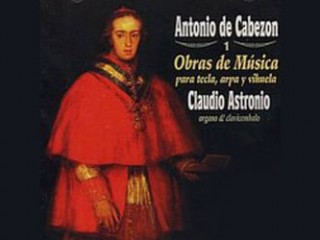
Antonio De Cabezón biography
Date of birth : -
Date of death : -
Birthplace : Castrillo de Matajudios, Spain
Nationality : Spanish
Category : Famous Figures
Last modified : 2010-12-17
Credited as : Composer, "Obras de música",
The Spanish organ composer Antonio Cabezón (1510-1566) was blind. But the conciseness, logic, drive, and consistency of his splendid "Obras de música" bespeak an interior vision of each piece in totality that sets him apart from all contemporary keyboard composers.
The supposition that Antonio Cabezón derived at least partially from Jewish ancestry, because he was born at Castrillo de Matajudios (near Burgos), remains unproved. Before the age of 16 he lost his sight. He studied organ at Palencia Cathedral, probably with Garcia de Baeza, and in 1526 was appointed organist to Isabel of Portugal, who became Emperor Charles V's wife that year. About 1538 Cabezón married Luisa Núñez of a vila, where they lived until 1560, after which the organist moved his household to Madrid.
In 1539 the Empress died, whereupon Cabezón alternated between service to her daughters and to Prince Philip. After 1548 he served the prince exclusively, traveling in his entourage to Italy, Germany, and the Netherlands during the next 3 years. He also accompanied Philip to England in 1554-1555. In both the Netherlands and England one of the royal keyboard players was Antonio's brother, Juan de Cabezón, and one of the choirboys was the blind organist's son Agustin. Cabezón's arrangement of the "hit song" le file quant Dieu me donne de quoi by Henry VIII's favorite lutanist, Philip van Wilder, was perhaps written during his English sojourn.
The Libro de cifra nueva, compiled in 1557 by Luys Venegas de Henestrosa, included 40 pieces by "Antonio," the blind virtuoso's fame already being so great that no other identification was needed. Cabezón's Obras de música para tecla arpa y vihuela was published in 1578 by his son Hernando. Among its varied contents are teaching pieces for beginners, hymn arrangements, 35 Kyries, 32 Psalm verses, 53 Magnificat verses, 32 fabordones, 12 tientos, 29 glosas of sections from Masses and motets by foreign masters, 10 variation sets (diferencias) on subjects ranging from Spanish folk tunes and French chansons to the Milanese galliard, and 18 glosas of French chansons. It also contains a Pavana italiana that in England became known throughout the rest of the 16th century as "The Spanish Pavan." The anthology provided "mere crumbs from my father's table," according to Hernando, who in his will dated Oct. 30, 1598, mentioned two other collections as ready for publication when royal bounty so allowed.
Cabezón's Obras de música began reaching the New World no later than 1586. In that year alone three copies were dispatched to Mexico City booksellers.
For information about Cabezón see Gustave Reese, Music in the Renaissance (1959), and John Ward, "Spanish Musicians in Sixteenth-century England," in Gustave Reese and Robert J. Snow, eds., Essays in Musicology (1968).
















